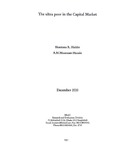The ultra poor in the capital market
Citation
Halder, S. R., & Husain, A. M. M. (2000). The ultra poor in the capital market. Research Reports (2000), Economic Studies, (XVI), 151–168.Abstract
This paper looks into the issue of accessibility of the capital market for the ultra poor
by analyzing the extent of borrowing, their sources and uses of loan. One-fourth had
access to any capital sources, and only about 5% received credit from any institutional
sources. The landless, female-headed households, households depending only on female
income, the wage-employed and the destitutes got less access to any kind of loan. On
the other hand, access to loan had increased with increasing land. It was also higher for
the households headed by male and for those depending only on male income.
Endowment and personal networking with creditors were very important in getting
access to any credit sources. Average interest rate paid for credit borrowed, irrespective
of sources, was 17.92%. Nearly one-fifth of the total loan obtained from different
sources was interest free. A maximum of 150% interest was also charged in Comilla
and Jamalpur regions. Institutional loans were mostly used for investment and
informal loan for crisis coping. The landless, female-headed households, wageemployed
group and the destitutes, in most cases, borrowed to meet their emergencies
and paid higher interest rate. Eighty-seven percent loan in Rangpur region were spent
for crisis coping whereas in Camilla and Jamalpur a significant proportion of the loan
was used for productive purposes.

